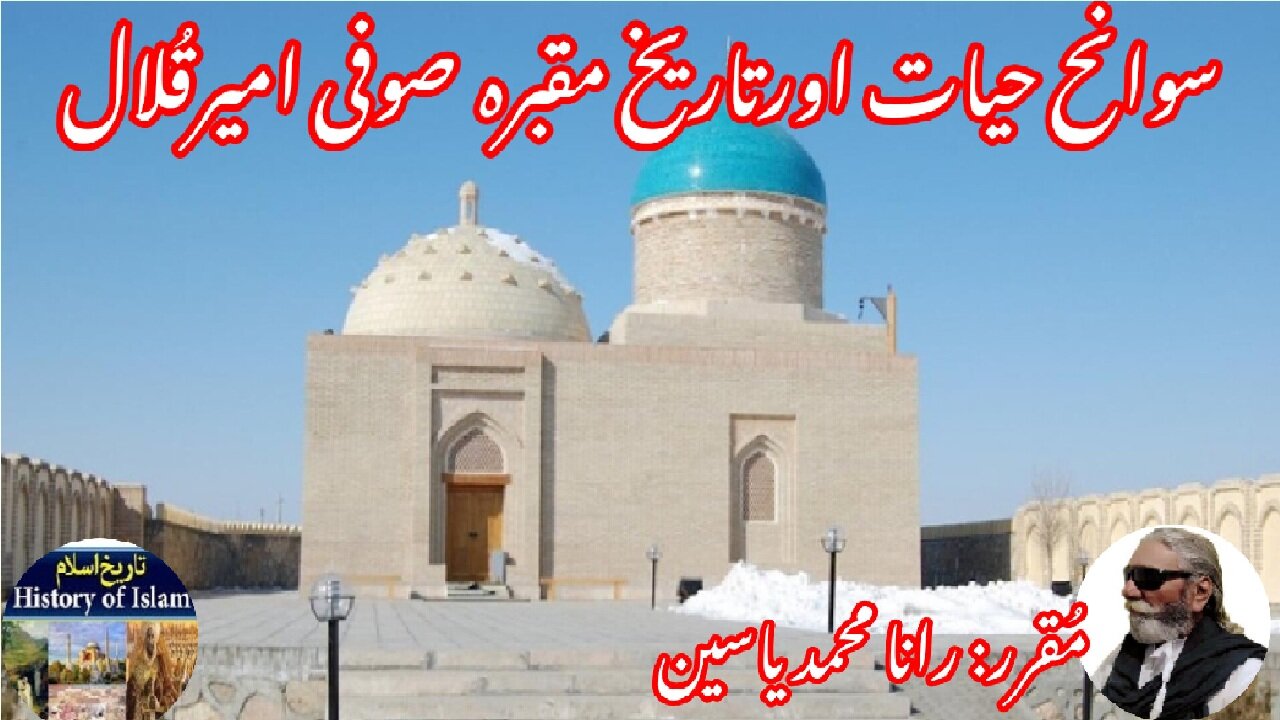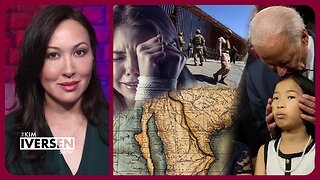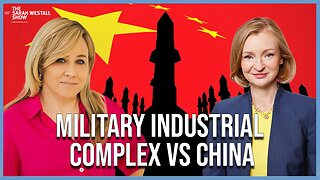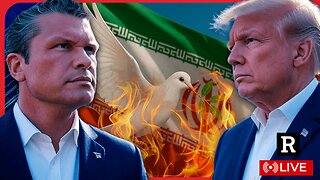Premium Only Content

Biography of Sufi scholar Amir Kala | सूफी विद्वान अमीर कलालl | صوفی عالم امیر کلال کی سوانح عمری
@islamichistory813 #Sufism #CulturalHeritage #AmirKulal
Biography of Sufi Islamic Scholar Amir Kulal
Dekhti Aankhooon aur sountay kaanoon ko Asslamoalaikum, sisters, brothers friends and elders, In this islamic sufi scholars informative video, we are presenting the biography of Amir Kulal, a revered Sufi Islamic scholar known for his profound insights and teachings. The narrative also encompasses the history of his shrine, situated in a culturally significant area, highlighting its importance as a center for spiritual reflection and community gathering. Get to know the life of Amir Kulal and the historical context of his shrine, which continues to inspire countless individuals.
Amir Kulal, birth name Shams ud-Din was a Persian Sufi Islamic scholar, widely considered to be one of the most influential in history. He was a member of the mystical Khajagan order. His father was the Sufi scholar Saif ud-Din Hamza, a sayyid descendant of Muhammad. Saif ud-Din Hamza was amir (chieftain) of the Persian Kulal-Tribe, his full title being Amir-i-Kulal. After his father's death, Shams ud-Din became the amir and head of the tribe. By this time his reputation as a scholar and religious figure had spread through Chagatai Khanate and the title Amir-i-Kulal, had become his common name. Because he made earthenware, he was popularly referred to as “Kul?l”, which means "potter" in Persian.
Shams ud-Din renowned as Amir Kulal, was born in Bukhara, Uzbekistan to the well known scholar Saif ud-Din Hamza a descendant of Nabi Muhammad. Saif ud Din Hamza (sometimes called Saif ud-Din Kulal) was also Amir (chieftain) of Tribe of Kulal (Amir-i-Kulal), hence the title Amir. After Saif ud-Din Hamza’s death Shams ud-Din took up the role of head of the tribe by which time his reputation as a scholar and religious figure had spread through Turkistan, and the title Amir-i-Kulal had become synonymous with Shams ud-Din, which stays to this day. He had number of students who later became prominent figures in history including Baha-ud-Din Naqshband and Amir Timur. He is buried at Sokhar (Sukhar), near Bukhara. After rise of the Timurid Dynasty a symbiotic relationship began between the houses of Amir Timur and Amir Kulal which continued through the Mughal line in India.
It is noted that Amir Kulal’s grandfather (also called Shams ud-Din) was the spiritual mentor of Barlas Tribe and Turghai (Amir Timur’s father) and is buried at Shahrisabz. Sometimes Amir Kulal’s grandfather is confused with Amir Kulal (both having the same name).
Shams ud-Din’s father, Amir Saif ud Din Hamza was head of the Kulal Tribe and a direct descendant of Husain ibn Ali, grandson of Nabi Muhammad. In fact the entire tribe of Kulal had descended from Nabi Muhammad and settled at Vabkent (Wabkana)–30 kilometers north of Bukhara. Around 1340 the city was visited by Ibn Battuta (1304–1359) who spent a night a night there as a guest. Ibn Battuta described the small city of Vabkent as beautiful with many gardens and rivers. Kulal Tribe had settled at Vabkent a number of generations back, near the end of the twelfth century. Their date of settlement can be approximated with the madrasa which was constructed at Vabkent in 1198 under the patronage of Burhan ud-Din Abdul Aziz II, whose name adorns madrasa’s minaret, the only surviving segment of the building. It is interesting to note here that the engineers working on construction of the madrasa were all from the Kulal Tribe and copied the Kalyan Mosque (Po-i-Kalyan) style, though few upgrades were made in the design and technology. In essence the Vabkent Madrasa was a more refined form of Kalyan Mosque.
Kulal Tribe quickly established a small industrial base at the central market of Vabkent and number of mills in the surrounding areas which continued to operate well into the sixteenth century. Minting of coins, steel, pottery and milling were the main industries. Though, the highly glazed pottery and tiles, unmatched in quality and quantity were their main export earning them the title of Kulal (potter). Their kiln designs were highly efficient and were able to produce up to 1500 pots in each batch. Utilizing wind and water resources for milling and industrial processes coupled with efficient kiln designs resulted in considerably higher returns per capita leading to a healthy lifestyle for the entire tribe.
Kulal Tribe lived in the surroundings of Burkhara and Bukhara city amidst the most turbulent times but remained safe and stayed out of the line of fire. Never in their history of few centuries were they attacked or their stronghold city destroyed. The reason lied in the threefold strategy.
Firstly, they were famous as an entire tribe of descendants of Nabi Muhammad, attracting considerable respect from the neighboring tribes, thus anyone bad-eyeing them had to think twice-the entire region being a Muslim dominated country. Secondly, the city was surrounded by a terrain of gardens and greenery crisscrossed by numerous rivers and streams at one side and an endless desert at the other, which was barren and uninhabited. This coupled with nothing much of material value in the small city was big enough deterrent for any invading army which would have to travel at least one day to reach the city which lied at the boundary of Kyzyl Kum (Qyzlqum) desert and no major city to north of the city.
Lastly, and most importantly their social system. The social system was devised into three sections, namely: political system; monetary system; and publicity system. Their political system was simple. The most learned of the tribe was chosen as the head. Main goal of the head, other than being the qazi and administrator was to represent the tribe and politically maneuver through times of war. Also the post was not hereditary. No hereditary claim to the “throne” meant there wasn’t one family in the tribe which would grow up to have amassed huge portions of tribe wealth in a couple of generations, in case the head turned out to be corrupt. Also, this avoided any mutual tussles between heirs of any deceased chieftain, as there was nothing to fight for. Their monetary system was even more advanced (for their time) than the political system. All of the mills and manufacturing plants were owned in essence by the community. Anyone willing and skilled was allowed to operate and earn a living as long as he kept the structure maintained and donated for construction of newer structures. The system worked superbly well and at least at a smaller scale of a couple of thousand individuals proved could be sustained for a number of centuries. Strict code of intermarriages within the tribe, relatively small birthrate (compared to the one prevalent at the times), single marriages and continuous outward migration meant the population stayed nearly constant throughout the time period.
The tribe used an ingenious method of publicity to deter any invaders. Although they were mainly craftsmen (engineers and scientists) but had strapping and tall builds. They used this to their advantage by encouraging young members of the tribe to learn the necessary fighting skills and take up wrestling as a sport which by the time of Shams ud-Din Amir Kulal had become a tribal trademark sport. The tribe held regular contests both at Vabkent and Bukhara in which outsiders also competed. Almost always success of Kulal’s youth meant instillation of the idea of Kulal Tribe as superior and fierce warriors. Thus, without ever going to war for a period of more than three centuries the tribe held its reputation as fierce warriors and wrestlers.
As head of Kulal, his responsibilities increased but Amir Kulal continued to teach at the madrassa. One of Amir Kulal’s most famous disciples was Baha-ud-Din Naqshband Bukhari who used to work as an executioner in Bukhara under the rule of Qazan Khan ibn Yasaur. One day Baha ud-Din was ordered to execute a man who had angered the king. However, right before his execution the accused called upon Amir Kulal, identifying him as his teacher. Amir Kulal intervened and the accused was set free on his intercession. This was Baha ud-Din’s first encounter with Amir Kulal. Impressed by him, Baha ud-Din became his student.
Amir Kulal also had a sizeable following of spiritual prote'ge's (murid). Of these the most prominent was Turghai (Trush) (d. 1356 AD) who had previously been influenced by Amir Kulal’s grandfather. After Turghai’s death his son Timur held Amir Kulal in the same esteem holding him as his spiritual guide.
Around the year 1340 Ibn Battuta made a day stop at Vabkent who later described the city as beautiful with many rivers and gardens. He was Amir’s guest at the city and was guided towards Bukhara, then at a day’s travel from Vabkent.
In the year 1357 Timur approached Amir Kulal for his advice on strategic maneuvers for attacking Uzbeks. It was under his advice that Timur changed his attack plan.
Amir Kulal died in 772/1370 and was buried in Sukhar (Sokhar) near Bukhara. Sometimes Amir Kulal’s tomb is confused with the tomb of his grandfather (also Shams ud-Din Kulal). It is Shams ud-Din Kulal (Amir Kulal’s grandfather) who is buried at Shahrisabz(Kesh); the Green City. Amir Kulal’s grandfather had constructed the madrasa Dor-i-Tilavat/Dorut Tilavat (House of Mediation) and was buried here after his death. Later, Timur transferred the body of his father Turghai, to be near the grave of Shams ud-Din (Amir Kulal's grandfather). Amir Kulal's grandfather was Turghai and Barlas Tribe’s spiritual mentor. Majority of Timur’s family is also buried at the same place. Recently, his tomb had been renovated under the orders of Uzbekistan’s President.
Sisters brothers friends, and elders, now give us permission, up to tomorow, and tomorow we will described Biography of Islamic Sufi Scholar Attar of Nishapur. Allah Hafiz
======================
-
 6:57
6:57
ISLAMIC HISTORY
8 hours agoQutb al-Din al-Shirazi | कुतुब अल-दीन अल-शिराज़ी | سوانح حیات قطب الدین الشیرازی اور مزار کی تاریخ
13 -
 LIVE
LIVE
Glenn Greenwald
2 hours agoPentagon in Turmoil Over Iran Policy as Israel Pushes for War; Lee Fang on New NIH Censorship Policy Threatening Medical Researchers | SYSTEM UPDATE #441
18,870 watching -
 1:01:57
1:01:57
BonginoReport
3 hours agoTampon Tim’s Daughter: “Trump Would Have Deported Jesus” - Nightly Scroll w/ Hayley Caronia (Ep.31)
64.5K81 -
 LIVE
LIVE
Kim Iversen
4 hours agoEXPOSED: How Joe Biden Turned America into the Child Trafficking Capital of the World
3,408 watching -

Sarah Westall
1 hour agoIs the Fight against China Real? Military Industrial Complex vs China w/ Dr. Rebecca Grant
5.18K -
 1:50:18
1:50:18
vivafrei
5 hours agoInterview with Nick Rekieta, Meghan Murphy! Liberals Go Fingers Up! Democrats Suicidal Empathy! AND MORE! Viva Frei
120K63 -
 54:58
54:58
Candace Show Podcast
4 hours agoWOAH! Shannon Sharpe Names His ‘Jane Doe’ Accuser. Is This The End Of #Metoo? | Candace Ep 180
79.6K64 -
 1:31:11
1:31:11
Redacted News
4 hours agoSomething BIG is happening at Trump's Pentagon and it's not good for peace | Redacted News
83.2K113 -

LFA TV
8 hours agoDems Fight Harder for Illegals Than for Citizens | TRUMPET DAILY 4.22.25 7PM
6.1K1 -
 LIVE
LIVE
RalliedLIVE
5 hours ago $1.36 earnedWarzone Wins All Night w/ Ral
193 watching